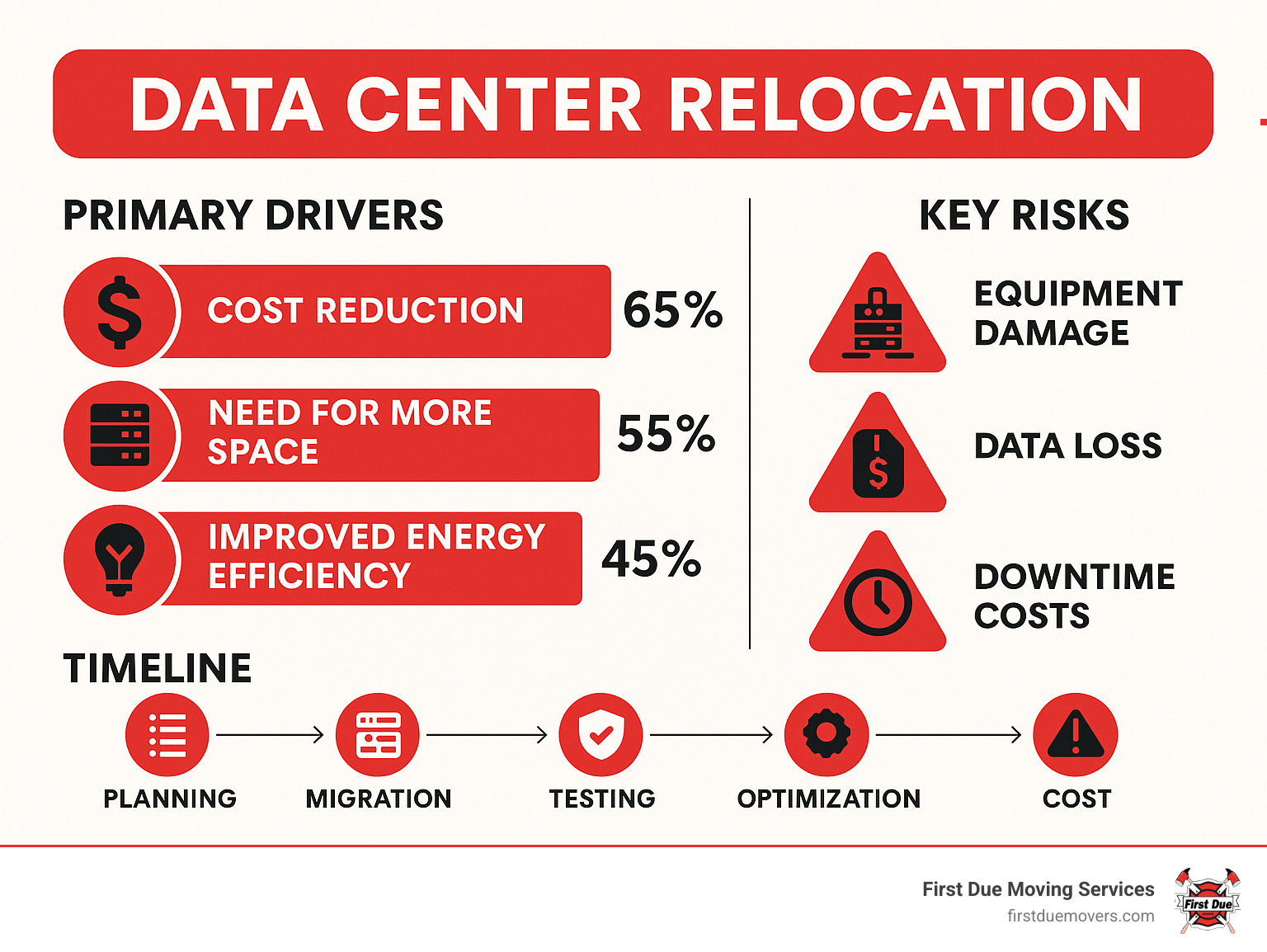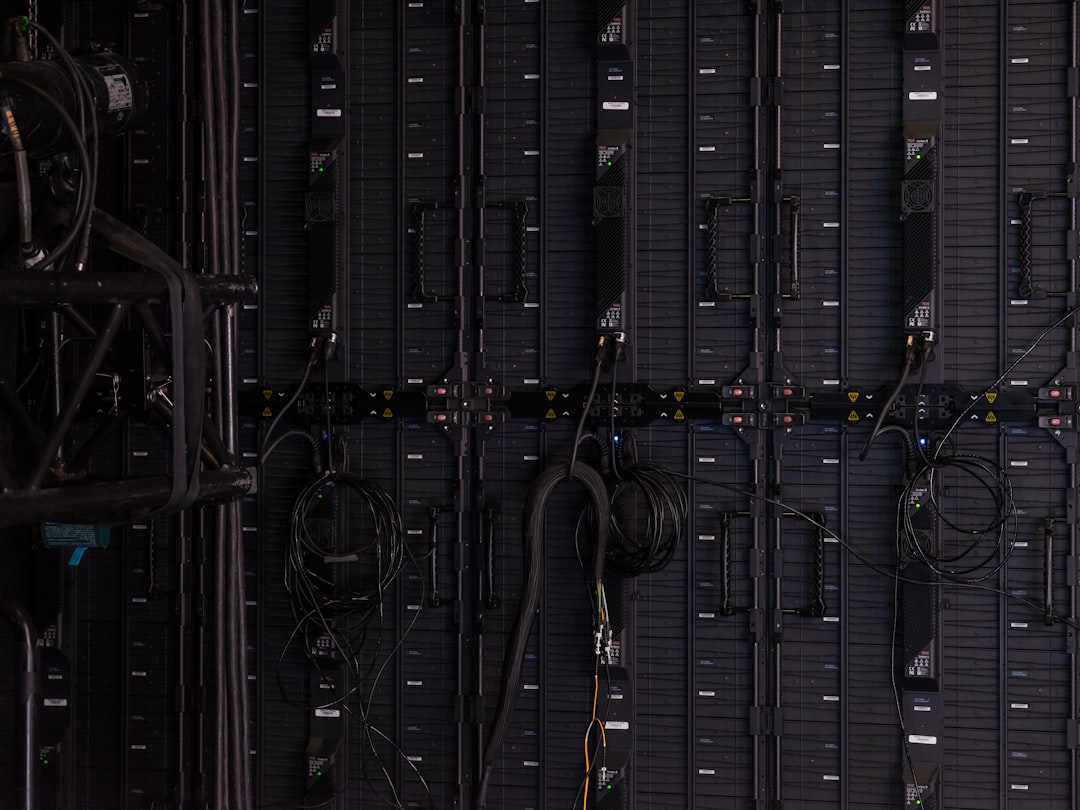The Ultimate Playbook for a Painless Data Center Move
.webp)

Why Data Center Relocation is Critical for Modern Businesses
A data center relocation is the complex process of moving IT infrastructure, servers, and critical systems to a new physical location. Whether upgrading, consolidating, or moving to a colocation facility, it requires meticulous planning and flawless execution.
Key Components of Data Center Relocation:
- Physical Move: Relocating servers, networking equipment, and storage systems
- Infrastructure Migration: Transferring workloads and applications
- Risk Management: Ensuring data security and minimizing downtime
- Testing & Validation: Confirming all systems work properly at the new location
The stakes are high. Downtime during a relocation can cost an average of $5,600 per minute, and with 60% of moves facing unexpected delays, meticulous planning is essential for business survival.
The data center relocation market is projected to grow to $25.7 billion by 2027, reflecting the drive for businesses to optimize IT infrastructure for cost, capacity, and energy efficiency.
As one experienced project manager wisely noted: “Spend 80% of your time planning, and the execution becomes the easy part.”
The difference between a successful move and a costly disaster often comes down to having the right team and following a proven playbook that addresses every critical detail.

Phase 1: Strategic Planning and Justification
A data center relocation is more than moving equipment; it’s a strategic business decision that can transform your company’s future operations.
The primary drivers for relocation are opportunities in disguise: 65% of moves are for cost reduction, 55% for space needs, and 45% for energy efficiency improvements. These are chances to build a stronger business foundation. Whether you’ve outgrown your space, face high energy costs, or need to meet new security requirements, you’re not alone.
Many states are rolling out the red carpet for data centers through attractive tax incentives, recognizing them as economic engines.
At First Due Moving Services, we approach every data center relocation as part of our commitment to streamlined business relocation. We know that behind every server rack is a business depending on seamless operations.
Understanding the Scope of Your Data Center Relocation
Before planning your move, it’s crucial to understand what type of project you’re facing. The first question is whether you’re dealing with a physical move or a virtual migration.
A physical move involves the careful disconnection, packing, transport, and reinstallation of your hardware. Our firefighter-trained team treats your equipment with the precision and care required in an emergency.
Virtual migration, on the other hand, is about moving your data and applications between systems, often without touching the physical equipment, such as shifting to the cloud or consolidating virtual machines.
Many clients choose a colocation facility—a high-tech shared space for world-class infrastructure support—while others opt for a complete new facility build-out to fit their specific needs.
Key Benefits of a Strategic Relocation
A well-planned data center relocation sets your business up for future success.
Improved ROI is a top benefit. Moving to an efficient facility can cut operating costs by 30% or more, freeing up capital for business growth.
Improved security and compliance is another key benefit. Modern data centers offer fortress-like physical security and certified systems, easing the burden of handling sensitive data and meeting regulatory requirements.
Increased IT infrastructure lifespan is a natural result of moving to a facility with superior climate control and power management. Relocation also provides the perfect opportunity to refresh aging equipment.
Perhaps most importantly, you’re creating scalability for future growth. You can move into an environment built to grow with you, ensuring your infrastructure can handle future demands.
Our team specializes in helping businesses maximize efficiency during commercial moves, ensuring you capture every possible benefit from your relocation investment.
Your Step-by-Step Plan for a Successful Data Center Relocation
A successful data center relocation requires meticulous project management, clear communication, precise budgeting, and careful vendor selection. We believe in dedicating 90% of the time to planning to ensure a smooth execution.

This task requires coordination across IT, operations, finance, and legal departments, as well as external vendors. Securing buy-in from all stakeholders early on is non-negotiable. A dedicated project manager with a deep understanding of your IT landscape is essential.
For any commercial move, we emphasize thorough Planning a Commercial Move to anticipate every twist and turn.
Asset Inventory and Documentation: The Foundation of Your Move
Attempting a data center relocation without a comprehensive asset inventory is like moving house blindfolded. This critical step is where many unexpected challenges arise, so meticulous documentation is essential.

Your asset inventory must be exhaustive, covering all hardware and software—from servers and switches to every last cable and fuse. Overlooking minor components can lead to major downtime and compatibility issues.
Beyond physical assets, you must map your entire network topology and identify application dependencies. Which applications rely on which servers? Application dependency mapping tools are invaluable here.
Equally important is gathering all warranty information and service contracts. You need to know if moving equipment will void warranties or violate service agreements. This is also a perfect time to audit your equipment, identifying mission-critical machines and phasing out outdated hardware.
Here’s an essential list of items for your asset inventory checklist:
- Hardware: Servers (physical and virtual), storage arrays, network switches, routers, firewalls, load balancers, power distribution units (PDUs), uninterruptible power supplies (UPSs), racks, KVMs.
- Software: Operating systems, applications, databases, virtualization platforms, monitoring tools.
- Connectivity: All network cables (type, length, port mapping), fiber optic cables, power cables, console cables.
- Configuration: IP addresses, VLANs, routing tables, DNS entries, firewall rules, server configurations, application settings.
- Documentation: Network diagrams, rack elevation diagrams, cabling plans, power schematics, logical and physical layouts.
- Contracts: Hardware warranties, software licenses, maintenance agreements, service level agreements (SLAs), vendor contacts.
- Dependencies: Application-to-server mappings, inter-application communication flows, external system integrations.
- Environmental: Power requirements (kW per rack), cooling requirements, space utilization.
- Consumables: Spare parts, specific tools, labels, packing materials.
This detailed documentation ensures we can re-establish a fully functional, optimized environment at the new location.
Minimizing Downtime and Ensuring Business Continuity
Downtime during a data center relocation is costly, averaging $5,600 per minute. Our goal is to minimize this disruption to ensure business continuity.
Effective downtime planning involves identifying application tolerance to prioritize the move. A robust communication plan is also vital, keeping all stakeholders informed of planned outages to build trust. To bridge the gap, strategies like using “swing gear” (temporary equipment) or setting up temporary hosting can keep critical operations running. Technologies like VMware vMotion can even allow for live migration of virtual machines, significantly reducing downtime.
However, the ultimate safety net is a comprehensive backup and recovery plan. Before anything is unplugged, all mission-critical data must be backed up. We advocate for the 3-2-1 backup rule: three copies of your data, on two different media, with one copy offsite. Crucially, you must test all backup data and software before the move. You can dive deeper into robust backup strategies with A guide to data center backup strategies.
Our commitment to Reduce Downtime Business Moving Services means we plan carefully to keep your operations flowing.
Ensuring Data Security and Integrity
Data security and integrity are paramount during a data center relocation. Protecting your most valuable asset is non-negotiable and central to our firefighter-founded principles of trust and integrity.
Physical security is key. Access to equipment must be strictly controlled during all phases of the move. We maintain a clear chain of custody for all sensitive equipment, documenting every transfer. We use dedicated, GPS-tracked, air-ride, climate-controlled transport for maximum security.
Beyond physical safeguards, data encryption is essential for data at rest and in transit. Strong access protocols, like multi-factor authentication, should be in place for personnel and systems. Any temporary network connections must be secured, and post-move monitoring of logs is vital to detect irregularities.
For any equipment being decommissioned, strict data sanitization methods—like degaussing or physical destruction—are crucial. Our Logistics Services Seattle WA are designed to ensure this level of care and security.
Phase 2: Execution, Testing, and Optimization
After months of planning, the execution phase of your data center relocation begins. This is where preparation pays off. Our firefighter-trained team brings precision, teamwork, and adaptability to the process, treating it like a critical response.
The execution phase starts with decommissioning. This is a choreographed process of systematically shutting down and de-cabling systems. We label every component with meticulous attention to detail, knowing that clear organization is key to successful reassembly.
Next is secure transport. Your servers are the heart of your business. We use specialized packaging to protect warranties and vehicles equipped for high-value IT assets, including climate control, vibration dampening, and GPS tracking.
At the new location, re-installation is methodical. Using the documentation from Phase 1, we reassemble your infrastructure, paying special attention to cable management. Clean cabling makes future maintenance easier and reduces the risk of accidental disconnections.
Our Commercial Moving Services are built around this foundation of precision and care, because we understand that your data center relocation isn’t just a move – it’s a critical business operation.
Post-Move Testing and System Validation
The physical move is just one part; a data center relocation is only successful once every system is running perfectly. We follow a rigorous testing protocol, never leaving success to chance.
We begin with a controlled system power-up sequence, bringing equipment online in a predetermined order to avoid conflicts. Next comes network connectivity tests to verify every cable, port, and VLAN. We check that IP addresses, routing tables, and network communications are correct.
Application functionality testing is where we ensure every critical application works as expected. Can users log in? Are databases responding? We involve your team in user acceptance testing, as they know your systems best.
We also run performance benchmarking against pre-move baselines to catch any degradation. Finally, we conduct thorough data integrity checks, reviewing logs and audit trails to confirm nothing was corrupted.
Only after every test passes and every stakeholder signs off do we consider your systems ready for full production.
The Final Step: Post-Move Evaluation for Future Success
Even after a smooth data center relocation, a final step remains: the post-move evaluation. Many companies skip this, but it’s crucial for turning the experience into valuable knowledge for the future.
We conduct a thorough project review with your team to capture lessons learned. This helps us refine our processes and provides you with invaluable knowledge for any future projects.
The evaluation also focuses on optimizing your new environment. We look for opportunities to improve performance, such as adjusting cooling, optimizing power consumption, or fine-tuning configurations.
We ensure all documentation gets updated to reflect the new setup. Accurate diagrams and inventories are essential for future troubleshooting and upgrades.
Finally, we gather staff feedback from daily users to address any lingering issues and ensure your team is confident in the new environment. This continuous improvement mindset means your data center relocation keeps delivering value long after the move is complete.
Frequently Asked Questions about Data Center Moves
When we talk with business owners about data center relocation, we hear the same concerns come up time and time again. Here are the questions we hear most often, with honest answers based on our experience.
How much does a data center relocation cost?
The cost of a data center relocation varies widely based on several factors, making it impossible to give a single price without understanding your specific needs.
The main cost factors are the size and complexity of your setup, the distance of the move, and the tolerable downtime impact. A move over a single weekend will cost more than one spread over several weeks.
Projects can range from $100,000 to over $1 million, with smaller operations often falling between $50,000 and $500,000. On a per-rack basis, costs are typically $5,000 to $25,000, depending on equipment density and specialization.
Hidden costs like overtime pay, staff accommodations, and re-certification can add up. We always recommend building in a 10-20% contingency buffer.
How long does a data center move take?
The timeline for a data center relocation depends entirely on the project’s complexity and the depth of planning required.
Key timeline factors include:
- Planning phase: This is the longest part. For 1-5 racks, plan on 2-3 months. For 6-20 racks, expect 3-6 months. For large enterprise moves (21+ racks), planning can take 6-12 months or more.
- Execution window: The physical move is often quick. For every 10 racks, the hands-on relocation might take only 1-3 days.
- Testing duration: This can vary from a few days for simple setups to several weeks for complex environments with rigorous protocols.
Typical lead times range from months to over a year, with most of that time wisely spent in preparation.
What is the biggest mistake to avoid in a data center relocation?
From our experience with countless data center relocations, the single biggest mistake is inadequate planning. This creates a domino effect of problems that can derail the entire project.
When planning is insufficient, common problems include:
- Poor inventory: Not knowing what equipment you have or how it’s configured leads to missing components and compatibility issues at the new site.
- Underestimating dependencies: Modern data centers are interconnected ecosystems. Failing to map dependencies means critical connections can be missed, causing major outages.
- Lack of a tested backup plan: Assuming your backups work is not the same as knowing they work. A failed backup during a move can lead to catastrophic data loss.
Statistics show that 60% of relocations face unexpected challenges, most tracing back to poor preparation. As Gartner research shows, proper planning can help avoid unexpected delays.
Investing in detailed planning, comprehensive inventory, and rigorous testing is the difference between a smooth transition and a costly disaster.
Conclusion: Partnering for a Flawless Transition
A data center relocation doesn’t have to be a stressful experience. The key is following the essential phases: from strategic planning and justification to execution, testing, and optimization.
The golden thread through every successful move is meticulous planning. As the saying goes: “Proper preparation prevents poor performance.”
At First Due Moving Services, our firefighter-founded background shapes our approach to your data center relocation. We operate with the precision, clear communication, and reliability required in an emergency, where there are no second chances.
Our firefighter-founded principles of trust, integrity, and professionalism are not just buzzwords; they are values tested in life-and-death situations.
Your data center is the heart of your business, and every component matters. We partner with your team to ensure a seamless transition, going beyond simply moving boxes to ensure nothing is overlooked.
When dealing with high-value equipment and downtime costs of $5,600 per minute, you need movers who understand the stakes. We’ve seen what happens when moves are rushed by teams who don’t appreciate the complexity. That’s not how we operate.
Our approach combines the systematic thoroughness of emergency responders with the personal service of a local Washington State company. We handle the heavy lifting—both literally and figuratively—so you can focus on running your business.
Ready to start planning your data center relocation? Whether you’re moving within Seattle, relocating to a new facility in Spokane, or making a cross-country transition, we’re here to make it happen smoothly. Contact our commercial movers in Kent, WA for a stress-free relocation and let’s begin mapping out your path to a successful move.


